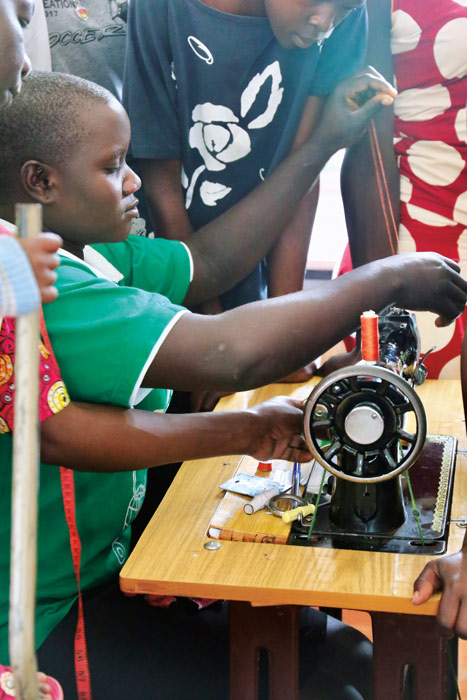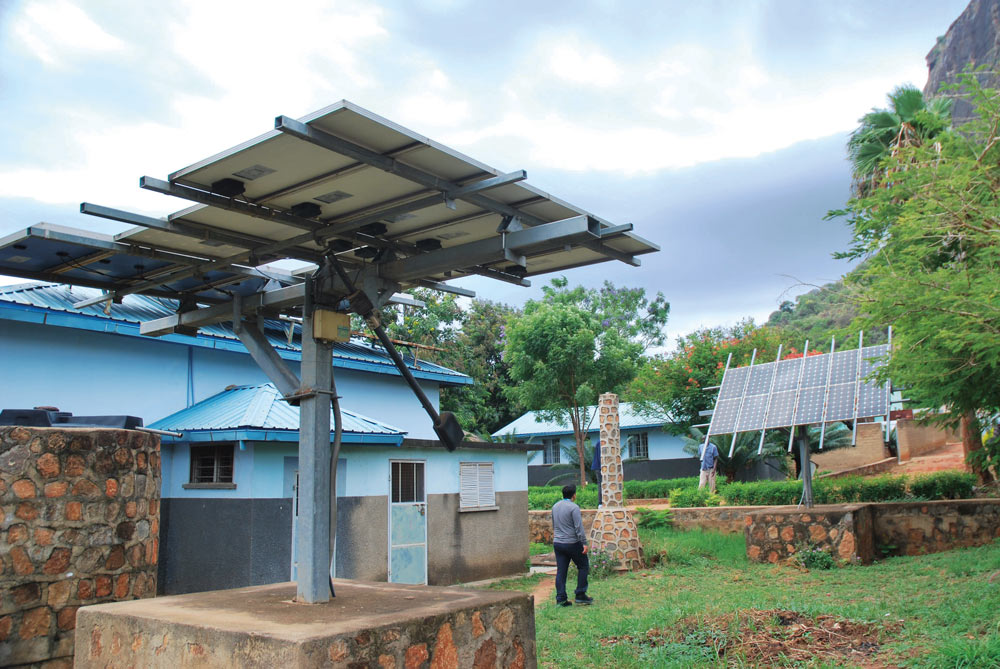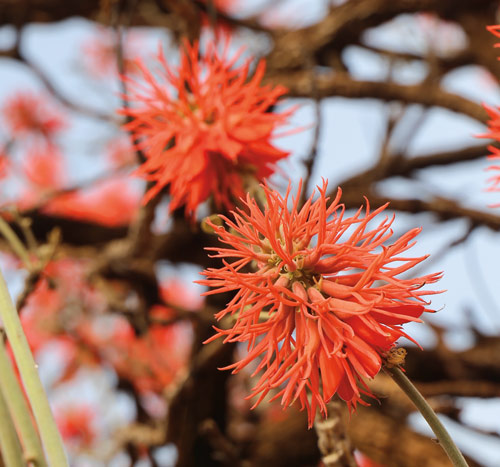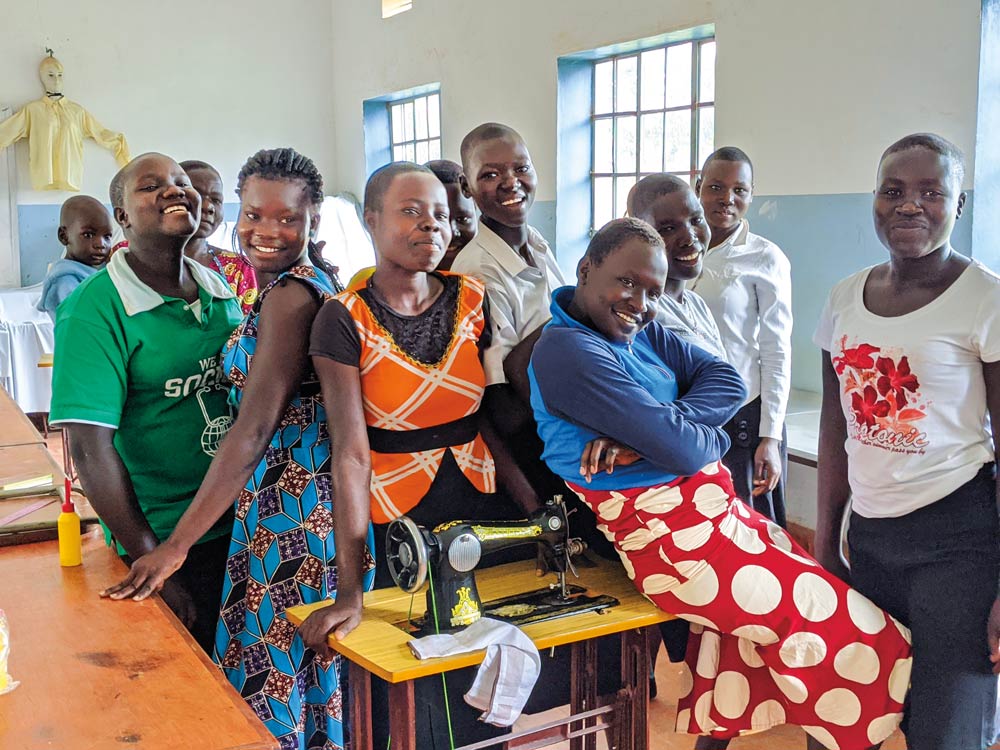IDEA GENERATION
Spring 2021
HOW A BUSINESS CLASS IS DESIGNING BETTER FUTURES FOR A GIRLS SCHOOL 8,400 MILES AWAY
 Kalongo seems a moonshot away from the University of Notre Dame. Located in the impoverished northern region of Uganda, the urban center with a population of about 15,000 offers limited options for young women coming of age in the country’s patriarchal society, where the power grid is unreliable and the average income is roughly a dollar a day. Added to those conditions, Kalongo is shadowed by a tragic legacy. In the 1980s, the ultra-violent rebel group the Lord’s Resistance Army abducted as many as 30,000 child victims to serve as soldiers and sex slaves. Most escaped or were released between 2003 and 2006. Very few had homes or families to return to and were often rejected by surviving members if they did.
Kalongo seems a moonshot away from the University of Notre Dame. Located in the impoverished northern region of Uganda, the urban center with a population of about 15,000 offers limited options for young women coming of age in the country’s patriarchal society, where the power grid is unreliable and the average income is roughly a dollar a day. Added to those conditions, Kalongo is shadowed by a tragic legacy. In the 1980s, the ultra-violent rebel group the Lord’s Resistance Army abducted as many as 30,000 child victims to serve as soldiers and sex slaves. Most escaped or were released between 2003 and 2006. Very few had homes or families to return to and were often rejected by surviving members if they did.
In early March 2020, a group of 10 Notre Dame students and their professor arrived in Kalongo, just ahead of the COVID-19-related travel shut down. They, along with 60 classmates back on campus, were part of the undergraduate Innovation and Design Thinking class taught by Wendy Angst, a teaching professor at the University of Notre Dame’s Mendoza College of Business and a fellow with the University’s Pulte Institute for Global Development.
In the months leading up to their visit, the students devoted countless hours researching, re-envisioning and reimagining a path forward for these young women through the work of a school founded just for this purpose — St. Bakhita’s Vocational Training Center (SBVTC).
Angst is a firm believer in the importance of experiential learning. She referenced a quote from Confucius: “I hear and I forget. I see and I remember. I do and I understand.” In past years, her students have applied their design thinking skills to real-world business problems for companies including the Disney Channel, LiveNation and Hearst Communications.
Three years ago, an anonymous donor endowed experiential learning for Angst’s classes. When St. Bakhita’s became the project focus in spring 2020, the donors offered additional support for students to have an opportunity to implement and test their ideas to have meaningful and long-lasting impact. This support has enabled Angst to look at a multiyear project with the center.
There are a number of ways to think about the work of the Innovation and Design Thinking class with the training center. It’s a learning experience for the students; an innovative approach to addressing societal issues; and an example of an extensive collaborative effort between the center, the University, aid agencies and a number of extraordinary individuals.
And at the very heart of it, the project is also about iteration, a word that simply means do-over. It’s the core concept of the design thinking model that the students applied to finding solutions for these young women. And it’s the core belief underlying the St. Bakhita’s project — that every life has infinite possibilities to start again.
A vivid example of what is at stake was illustrated to the students by a set of 16-year-old twins — “Mary” and “Elizabeth.” One of 10 children, Elizabeth was able to attend SBVTC by raising money for tuition by growing cassava and maize in her family’s garden. Even more critically, her aunt acted as an advocate for her to go to the school, where she studies tailoring. Otherwise, it’s likely that the family would prioritize keeping her at home to help with subsistence farming and childcare. But her twin wasn’t as fortunate. She was married off to a 38-year-old man for the dowry.
“And it just happened that while we were at the school, the night before we left, Elizabeth’s sister came to visit,” said Angst. “Elizabeth hadn’t seen her since the wedding. Her sister was now eight months pregnant. It was just heart-wrenching to think about the very different futures that lay ahead for these girls.”
START WITH EMPATHY
 Traditional humanitarian efforts in situations like this might call for aid, but here’s where the design thinking approach is decidedly different. Design thinking begins with putting yourself in the shoes of the user to live the problem from the user’s perspective. The focus is to think about a problem through a holistic and flexible process focused on empathy for those you are seeking to serve, to ensure the creation of a human-centered solution.
Traditional humanitarian efforts in situations like this might call for aid, but here’s where the design thinking approach is decidedly different. Design thinking begins with putting yourself in the shoes of the user to live the problem from the user’s perspective. The focus is to think about a problem through a holistic and flexible process focused on empathy for those you are seeking to serve, to ensure the creation of a human-centered solution.
Because it is necessarily a collaborative approach, design thinking is often considered an effective way to tackle complex socio-economic problems such as health care and education that do not have straightforward answers.
The approach typically involves five steps: empathize, define, ideate, prototype and test. These translate into developing an understanding of the human needs at the center of the problem or challenge; reframing the problem in human-centric terms, generating a lot of ideas for possible solutions, and developing and testing prototypes in an iterative fashion.
At every step, the design thinkers make alterations and refinements to the innovations in order to keep driving toward the solution that best meets the current and future needs of the user. It’s a hands-on approach that encourages a deep level of trust in the process and an aptitude for creative problem solving.
For the Notre Dame team, the spring break trip provided a chance to build on their understanding of the realities facing the school and its students and to experience the school and the environment firsthand. As part of their in-country research, they sat in on classes at St. Bakhita, visited the farm affiliated with the school, met Ugandan entrepreneurs and toured other vocational programs. They also took time to get to know the SBVTC teenagers.
Sophia Kartsonas (MGT-Consulting ’21) was struck by the contrast between her and Elizabeth. “When I was 16, I was a junior in high school and the biggest cause of stress in my life was over whether I would pass my driver’s test,” she says. Meanwhile, Elizabeth worries about whether she’ll be able to find a joband send money back home to her family and if her
younger sisters will have the same fate as her twin.
But the experience also worked in the opposite direction, with students deeply impressed by how much they shared. “We met bright and determined women fighting for reforestation, an altruistic principal focused on creating a self-sustaining academic institution, and many girls seeking better futures through education,” said Aubrey Flagler (BBA ’20). “Without being there in person to meet each of these people and see their world alongside them, we would not have been able to design for St. Bakhita’s with true awareness and empathy.”
INNOVATION ACRES
Shortly after the students returned to campus, all Notre Dame classes transitioned to online teaching due to COVID-19. Working virtually, the Innovation and Design Thinking students moved to the next steps of the process by “ideating” ways to improve the lives of the “Elizabeths” and the “Marys.”
 The solutions extended beyond the primary mission to provide young women with opportunities to learn employable skills to include improving access to healthy foods and supporting affordable and environmentally responsible alternatives for families to meet their energy needs. As it happens, Uganda is in the midst of a massive deforestation crisis. More than 86% of households depend on the burning of charcoal and wood as their energy source, which has led to the destruction of more than 60% of its forests.
The solutions extended beyond the primary mission to provide young women with opportunities to learn employable skills to include improving access to healthy foods and supporting affordable and environmentally responsible alternatives for families to meet their energy needs. As it happens, Uganda is in the midst of a massive deforestation crisis. More than 86% of households depend on the burning of charcoal and wood as their energy source, which has led to the destruction of more than 60% of its forests.
The Innovations and Design Thinking team saw the challenge as two-fold: 1) addressing the social and economic devastation left by the LRA, particularly the impact on young women, and 2) addressing Uganda’s growing deforestation crisis.
The proposal that emerged was the Teaching Reforestation & Entrepreneurial Empowerment at St. Bakhita’s, or the TREES Initiative. Centered on building a sustainable agri-business, the plan starts with establishing 50 “Innovation Acres” that will initially focus on planting a variety of fruit, avocado and charcoal trees. St. Bakhita’s students will learn the practical skills and value of agroforestry and environmental preservation and also become equipped with the entrepreneurial knowledge needed to harvest and sell these products. Work on the farm and the resulting revenues will be used to help offset tuition fees and expand the school.
In the process, St. Bakhita’s students will gain a sense of empowerment and learn practical skills such as how to open a bank account and manage money. In turn, they will be encouraged to take these skills and share them in their communities, becoming local change agents who create the inspirational foundation for Uganda’s new generation of female leaders. The initiative includes developing a support network for students and graduates, and longer-term support for entrepreneurial endeavors.
It’s important to note that at this point, the St. Bakhita’s project involved not just the Innovation and Design Thinking class, but an extensive and extraordinary collaboration. Advisers have included alumni affiliated with nonprofits working in Uganda and other Notre Dame students, both graduate and undergraduate, eager to support the creation of a successful program at St. Bakhita’s.
Notre Dame collaborators and advisers included the Pulte Institute, the Keough School, the Center for Social Concerns, the Alliance for Catholic Education and the Notre Dame MBA. Pulte Institute fellow Tom Loughran, a board member of nonprofit BOSCO Uganda which previously set up 14 computers at St. Bakhita’s, traveled with the team. Father Joe, the priest with the Archdiocese of Gulu which oversees the school, continues to help oversee the work on the ground in Uganda in collaboration with Jennifer Okusia, CEO of BOSCO Uganda.
Mendoza alum Matt Alverson (BBA ’01), a partner with global innovation and design consultancy IA Collaborative and adjunct instructor for the Notre Dame Executive MBA program where he teaches Design Thinking for Business, frequently joins the weekly calls to help think through the challenges that arise.
The methods they use for the St. Bakhita initiative are the same used by market innovators like Nike, Airbnb and Amazon,” said Alverson. “Wendy is doing the hard work of combining learning with social impact. Father Sorin declared Notre Dame would be ‘a powerful force for good,’ and this work delivers on that vision.”
CATALYSTS FOR CHANGE
When Angst’s class ended in May 2020, COVID-19 continued to wreak havoc globally. In Uganda, the government had issued a national stay-at-home order mere weeks after the team’s visit. All SBVTC students were sent home immediately.
 For Angst, this meant it was time to double down on their efforts. The pause granted the team the opportunity and time to “redefine the what, how and why of the school’s curriculum.”
For Angst, this meant it was time to double down on their efforts. The pause granted the team the opportunity and time to “redefine the what, how and why of the school’s curriculum.”
During the summer, a team of students continued researching vocational schools in Uganda and abroad, determining best practices with regard to curriculum scope, tuition payment systems, teacher recruitment strategies, marketing and post-employment activities. In fall 2020, the team built a new website for the school and developed a program for partial tuition scholarships. They received approval to launch a Notre Dame club, Innovation for Impact, to include other Notre Dame students in advancing the work beyond the classroom and to provide pathways for the Notre Dame community to engage in fundraising and partnerships for SBVTC. They launched a GoFundMe campaign that has raised about $44,000 to date in additional funds to help support the TREES initiative.
Perhaps most critically, they realized the importance of establishing in-country leadership at St. Bakhita’s, which included hiring Victoria Nyanjura, a 2020 graduate of the Keough School’s Master of Global Development program, to serve as a technical advisor. Nyanjura was herself kidnapped by the Lord’s Resistance Army from her school in 1996 and held hostage for eight years, suffering brutal beatings and rape before eventually escaping. (Read more about Nyanjura’s story in Notre Dame Magazine’s “Eight Years a Captive.”)
As the difficult fall 2020 semester drew to a close, Angst reflected with deep appreciation for the work of the Innovation and Design Thinking students, the benefactor and the many others who devoted time and energy to the St. Bakhita’s project. She returned to a statement that serves as a theme for the class: Not all credit hours are created equal.
“In other experiential classes I have taught in the past, we get to the point where the students come up with really phenomenal recommendations, but then the semester ends. We leave the recommendations with the client and move on,” she said. “But here, we made the commitment that this would be our project focus for the next three to five years, to enable meaningful impact through implementation of student initiatives.”
The next class of Innovation and Design students began their work with St. Bakhita’s in spring 2021. The new cohort of SBVTC students have been designated as the “Innovation Scholars” with the expectation that they will work closely with their ND counterparts to collaborate, iterate and prototype a reimagined future for best-in-class vocational education.
“And as you might imagine, working with a school like St. Bakhita’s involves your full heart and mind,” said Angst. “There is so much need, but even more opportunity. The opportunity to take our classroom across the world to work with these incredibly strong and resilient girls. The opportunity to collaborate with partners here and around the world. The opportunity to learn by doing. The opportunity to make a difference. To me, this embodies what it means to be a part of this amazing Notre Dame community.”

Comments